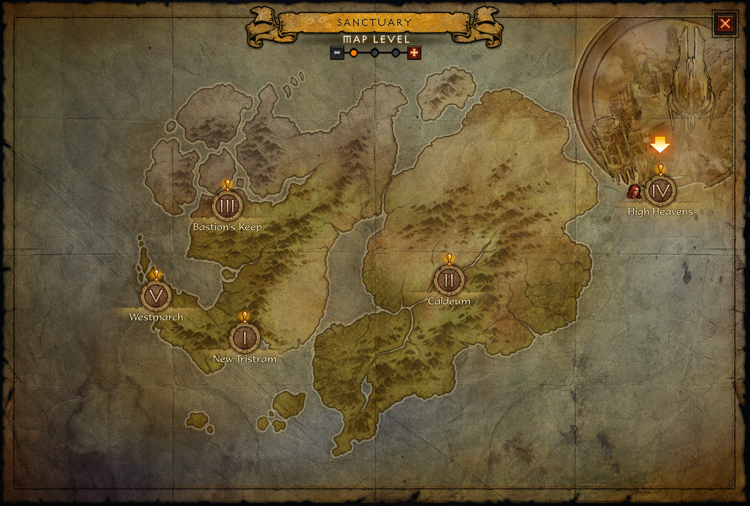
Sanctuary was created by an angel named Inarius, a demon named Lilith, and a group of renegade angels and demons who wanted to opt-out of the Eternal Conflict.
For a while, they believed they were safe. They thought that Sanctuary was hidden from both the angels and the demons. But, what happened in Sanctuary didn’t stay in Sanctuary.
To summarize greatly, Sanctuary was created by Inarius (an angel) and Lilith (a demon) who no longer wanted to fight in the Eternal Conflict. They were assisted by other renegade angels and demons, and together pretty much committed blasphemy.
They stole the Worldstone, and used it to create Sanctuary. There, they believed they would be safe. Their assumption was that neither the angels nor the demons would be able to find Sanctuary.
Lilith, who knew that Inarius was in love with her, wanted to give him children. They had one child, a son, whom they named Linarian (a combination of his parent’s names). Linarian was the very first Nephalem. Lilith was now considered the “mother” of all the Nephalem.

Other renegade angel and demon couples also had children together. Those kids were also part of the first generation of Nephalem. According to The Book of Cain, this first generation were eventually called the Ancients (by future generations).
The first generation of Nephalem included Linarian, Bul-Kathos, Vasily (who was Bul-Kathos’ younger brother) and Esu. Deckard Cain speculates that no one knows how many of the first Nephalem, or “demigods”, have been forgotten over time.
The Nephalem were part angel and part demon. They were strong, and had special abilities. Lilith might have viewed this unexpected situation as something useful. She may have wanted them to become her army.
Inarius, on the other hand, was troubled by the strength of the Nephalem. There is a journal that players can pick up in Diablo III that is called “Testament of Inarius Part 7”. It provides some explanation about what Inarius was thinking.
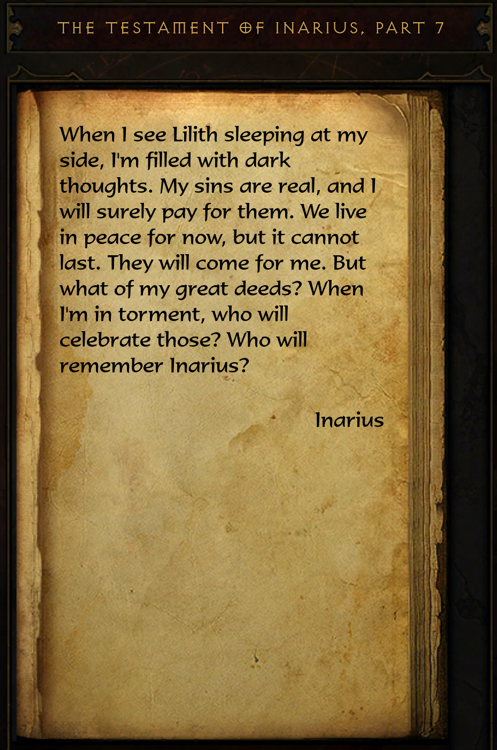
Inarius: When I see Lilith sleeping at my side, I’m filled with dark thoughts. My sins are real, and I will surely pay for them. We live in peace for now, but it cannot last. They will come for me. But what of my great deeds? When I’m in torment, who will celebrate those? Who will remember Inarius?
In short, Inarius was having mixed feelings about what he and Lilith created. On one hand, Inarius no longer believed that angels having children with demons was a good idea. This first generation of Nephalem were stronger and more powerful than their parents.
Inarius thought that it was possible that the power of the Nephalem would somehow attract the attention of both the High Heavens and the Burning Hells. If Sanctuary were found, both sides would consider the creation of these hybrid children, and the theft of the Worldstone, to be blasphemy. There was a price to pay, and it would be a high one.
At the same time, Inarius desperately wanted there to be someone who would remember him for his great deeds. It sounds as though he strongly suspected that he would face “torment” over what he had done. He wanted the consolation that he would not be forgotten about.
It is not clear how long Inarius kept these thoughts to himself before speaking to the other renegades about them.
Eventually, he shared his thoughts. This brought conflict. Some of the renegades were convinced that their offspring should be destroyed, while others wanted them spared. Inarius called for a period of reflection, where they each could think things through in solitude.
According to the Book of Cain, followers of Inarius agreed to that plan. There probably were others who chose not to do so. Inarius, being an angel, was trying to create order. The renegade demons probably were more focused on chaos. It is possible that there were some angels who wanted to spare the Nephalem, and some demons who wanted them slain.
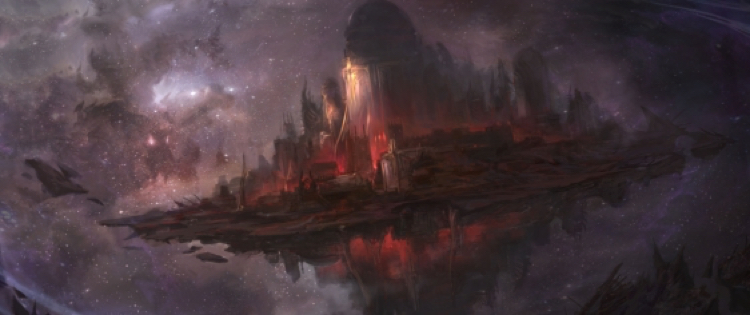
Meanwhile, the Eternal Conflict continued. The goal of this never ending battle is to obtain the Worldstone. The angels, and the demons, went to the Pandemonium fortress and waged war. Each side hoped to win the Worldstone. They would later lose it to their opponents. And so on, and so on.
This time, to everyone’s surprise, the Worldstone was missing. It simply wasn’t there. The angels were absolutely baffled by this. They thrived on order, and had every expectation that the Worldstone would be where it was supposed to be.
The demons, who were beings of chaos, were not surprised. Creatures that thrive on chaos apparently are less shocked when faced with the unexpected. As such, some of them kept fighting.
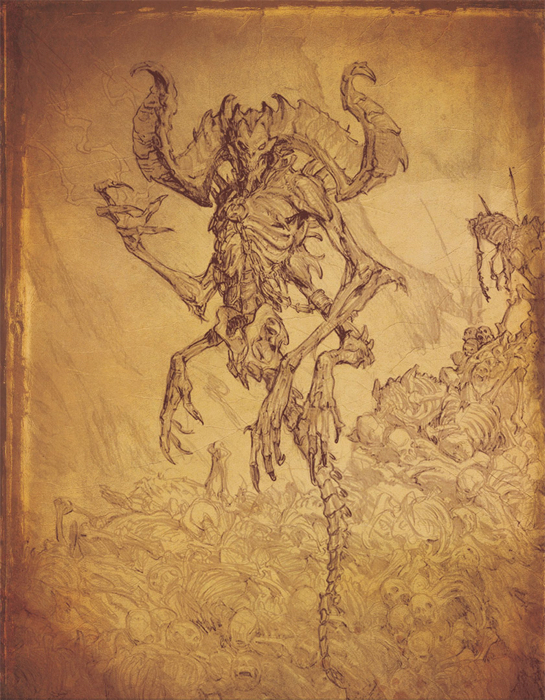
Mephisto, Lord of Hate, who is one of the three Prime Evils, was leading this particular battle. He noticed what his troops did not.
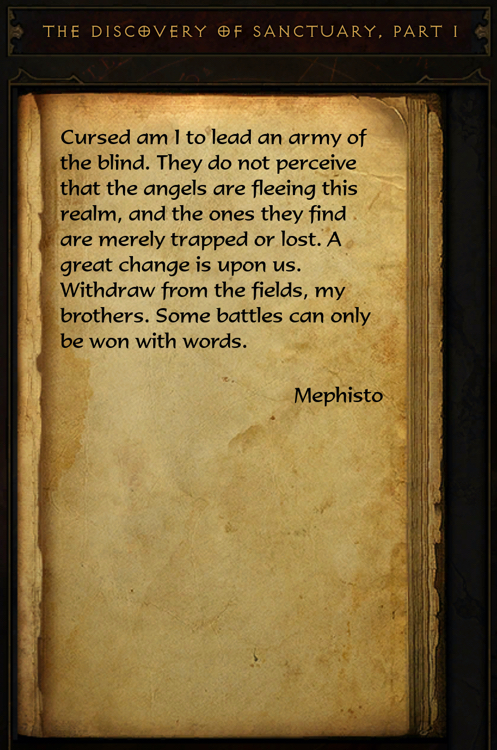
There is an in-game journal that players can pick up in Diablo III called “The Discovery of Sanctuary, Part I”. It is from the viewpoint of Mephisto.
Mephisto: Cursed am I to lead an army of the blind. They do not perceive that the angels are fleeing this realm, and the ones they find are merely trapped or lost. A great change is upon us. Withdraw from the fields, my brothers. Some battles can only be won with words.
Baal, Lord of Destruction, was also present at this battle. He shared his observations about the missing Worldstone with Mephisto.
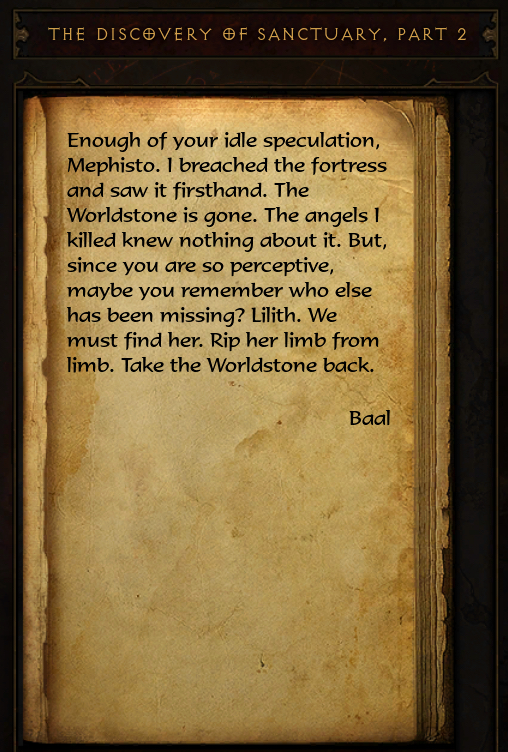
There is an in game journal that players can pick up in Diablo III called “The Discovery of Sanctuary, Part 2”. It is from Baal.
Baal: Enough of your idle speculation, Mephisto. I breached the fortress and saw it firsthand. The Worldstone is gone. The angels I killed knew nothing about it. But, since you are so perceptive, maybe you remember who else has been missing? Lilith. We must find her. Rip her limb from limb. Take the Worldstone back.
Lilith is the daughter of Mephisto, Lord of Hatred. He also has a son named Lucion. One could reasonably assume that the Lord of Hatred hates his children. In the Book of Cain, Deckard Cain wrote that Lilith “suffered from the hatred of her father from time immemorial” and had long awaited an opportunity to rebel.
It seems that Baal was able to put all of that together and assumed that Lilith stole the Worldstone in an effort to anger her father. This was something that Mephisto apparently had not considered. The search for Lilith began.
On Sanctuary, an event occurred that the Book of Cain calls “The Purge”. Deckard Cain included in his book an anonymously written text that was found uncatalogued in the Great Library of Caldeum. Deckard Cain states that this tale “strains credibility”, but included it anyway because “untangling myth from history is a tricky business”.

The text says:
Lilith, the first mother of the nephalem, was driven into a mad frenzy by the threat of her children’s extinction. She morphed into a far more horrific form than any had ever seen – of tooth and claw, of spike and blade – and hunted down her fellow renegades. She ruthlessly murdered each and every follower of Inarius, leaving only him to discover the carnage she had wrought.
Inarius was horrified by the loss of his comrades and the terrible deed that his lover had committed. Through enraged, he could not bring himself to kill Lilith, but instead banished her from the sanctuary they had made.
Inarius then attuned the Worldstone to cause the powers of the nephalem to diminish over time. He then disappeared – though some say he still walks among us in a form more closely resembling our own.
According to Diablo Wiki, Inarius banished Lilith to place called the Void. It is described as: “an endless empty realm where individuals can be trapped. The Void is described as endless darkness, blacker than black and completely empty.”
Inarius then killed many of the Nephalem. Some survived. Linarian, son of Lilith and Inarius, was still around. Linarian gathered some of the other members of the first generation of Nephalem, in an attempt to save them from his father’s killing spree.
Linarian changed his name to Rathma, possibly in an attempt to separate himself from his parents. He values the balance between light and dark above all things. One could reasonably assume that he made an effort to avoid running into his father.
Over time, the power of the Nephalem faded, due to Inarius tinkering with the Worldstone. He may have believed that their reduced power meant that they would no longer attract the angels or the demons. Sanctuary was safe.
That said, there is reason to believe that some of the original Nephalem who survived held on to their powers. They might not have been quite as strong as before, but were not as weak as the later generations of Nephalem.
Eventually, one of the humans decided to try and contact “spirits”. Jere Harash was a member of the Vizjerei sorcerers. In short, he figured out a way to summon a demon. The Vizjerei clan decided that the existence of demons should be kept a secret. This decision didn’t stop them from summoning more and more demons.
One could reasonably assume that if enough demons went missing from The Burning Hells, their masters would take notice. I think this situation explains how and why the demons discovered Sanctuary before the angels did. They wanted their minions back.
Of course, the Prime Evils wanted to take advantage of this situation. According to the Book of Cain, Diablo, Mephisto, and Baal “cast their influence upon mortal minds and twisted their ideas”.
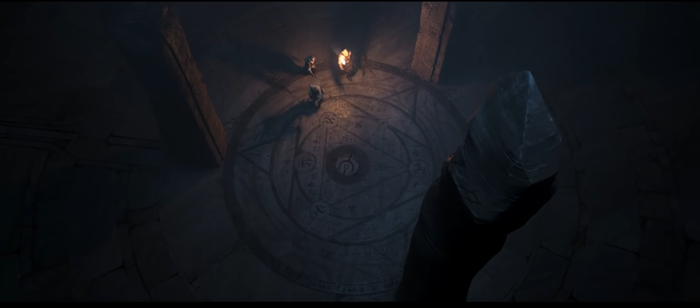
This led to the formation of the Triune. Humans who followed this religion believed they were worshiping three benevolent spirits: Dialon, spirit of determination; Mefis, spirit of love; and Bala, spirit of creation.
They didn’t know that they were actually worshiping Diablo, Mephisto, and Baal. The Triune was led by Lucion, who was the son of Mephisto (and Lilith’s brother). The humans called Lucion “The Primus”.
The demons of the Prime Evils had established themselves in Sanctuary. According to the Book of Cain, they kept that information to themselves, and didn’t share it with their lesser brethren.
After learning about the existence of the Triune religion, Inarius recognized that the Prime Evils were behind it. In response, he established the Cathedral of Light. He became the Prophet, and took on the form of a young, strikingly beautiful, human-looking man who never aged. He taught his followers a doctrine of tolerance, cooperation, and unity.
Through this, Inarius may have believed he found a way to have his great deeds celebrated, and to be remembered.
This led to The Sin War, which actually started when the Triune and Cathedral of Light religions were formed. The Prime Evils, and Inarius, were actively trying to influence the hearts and minds of the humans.
Lilith, who had somehow escaped from the Void, returned to Sanctuary. She took on the form of a human noblewoman, and called herself Lylia. She seduced a farmer named Uldyssian after he defended her from a priest who was representing the Cathedral of Light.
Uldyssian discovered that he had developed great powers. This happened because Lilith intentionally awakened those dormant powers. Of course, Uldyssian didn’t know she had done this. He also didn’t know that Lylia was actually Lilith (until later when that was revealed).
Uldyssian was strongly disliked by both the Triune and the Cathedral of Light. Both sides accused him of assassinating their members. Both sides wanted to find a way to make use of him, or to destroy him.
Uldyssian helped other humans unlock their powers. He became the leader of a powerful group of mortal humans, called the Edyrem, who followed him unquestionably.
To make a long story short, the Primus of the Triune disappeared, causing it to fall into disarray. The Primus then returned, but Lucion did not. Lilith disguised herself as her brother and became the Primus. She set about destroying the main Temple of the Triune from the inside.
Inarius was able to recognize Lilith, and he banished her to the Void again. Inarius also banished Rathma to the Void (sometime during The Sin War). Trag’Oul tried to retrieve him, but Rathma was too far out of his reach. Mendelin, Uldyssian’s younger brother, who had met both Trag’Oul and Rathma, was sent to get Rathma out of the Void.
From this, it sounds like Lilith, and her son Rathma (Linarius) were in the Void at the same time.
Uldyssian’s army then set out to fight against Inarius and the Cathedral of Light. Some significant things happened as this battle was waging. Uldyssian and Inarius fought each other, and turned out to be equally matched in power. Sanctuary shuddered as they collided.
Trag’Oul, is a “cosmic dragon” who materialized in Sanctuary shortly after The Purge. He and Rathma had been assisting Uldyssian. Trag’Oul was no longer able to keep Sanctuary cloaked from the High Heavens. This made it possible for the angels to find Sanctuary. The demons showed up shortly after that. The battle now had three separate sides, and each one wanted to slay the other two.

The battle ends with a bang. The Book of Cain explains it this way:
Uldyssian realized that the power he and his edyrem possessed was tearing Sanctuary apart. It was too much, gained too quickly. He felt also that he was losing himself – that his nephalem birthright was consuming his humanity – and he saw in that moment the potential for nephalem power to do the same to all humankind.
And so, in an act of the purest selflessness and sacrifice, which proved beyond a doubt that some humanity still remained within him, Uldyssian brought the raging energies back into himself, then released them one final time. The release of those energies negated his very being.
The battle was over. The members of the Angiris Council, and Mephisto, spoke to each other about what could be considered “the spoils of war“.
According to the Diablo Wiki, Mephisto offered to let Sanctuary be untouched by either angel or demon to see what the children (the human descendants of the Nephalem) may become on their own.
An agreement was made between Mephisto and the Angiris Council that Mephisto would cast his mark on the ruins of The Cathedral of Light to seal the flux between the worlds. In exchange, Mephisto wanted to take Inarius as a prisoner of war. The Angiris Council agreed to that exchange.
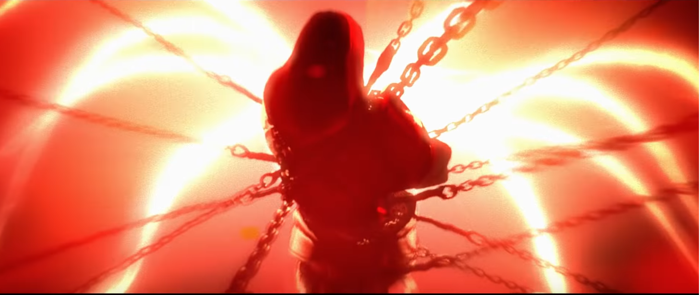
Inarius was right. The actions he had taken were considered blasphemy by not only the angels, but also the demons. Mephisto took Inarius to the Burning Hells, where he was tortured, forever. It is unknown if Inarius found comfort in his belief that perhaps some of the followers of The Prophet would remember him.
The Angiris Council now had to figure out what should be done with the humans. Should the humans be allowed to live? They held a vote.
Imperius, Archangel of Valor, voted to exterminate the humans. Auriel, Archangel of Hope, voted to allow the humans to live. There are in-game journals in Diablo III that players can pick up that explain Auriel’s viewpoint of what happened in Sanctuary.
To me, it sounds like these journals were written after the Angiris Council left Sanctuary and returned to the High Heavens. She wouldn’t have had time to write them until then. The main purpose of these journals is to give the player some information about what happened in Sanctuary.
The Creation of Sanctuary, Part 1 says:

Archangel Auriel: I new Inarius long ago – when he was still among the angels. But he grew weary of battling the demons after a time, and he began to secretly conspire with demons in order to forge a peace. The demoness Lilith became his greatest ally in the Hells, and many other demons and angels joined the cause.
The Creation of Sanctuary, Part 2 says:

Archangel Auriel: After he gained a following, Inarius stole the sacred Worldstone and used it to create and conceal a world he called Sanctuary. Demons and angels alike fled there, and some of them – including Inarius and Lility – fell in love. Many of these unions resulted in children. They were called the nephalem.
As I mentioned earlier, I don’t think that Lilith was actually in love with Inarius, even though she knew Inarius was in love with her. Archangel Auriel does not appear to realize this. Maybe she hoped they a happy couple.
The Creation of Sanctuary, Part 3 says:
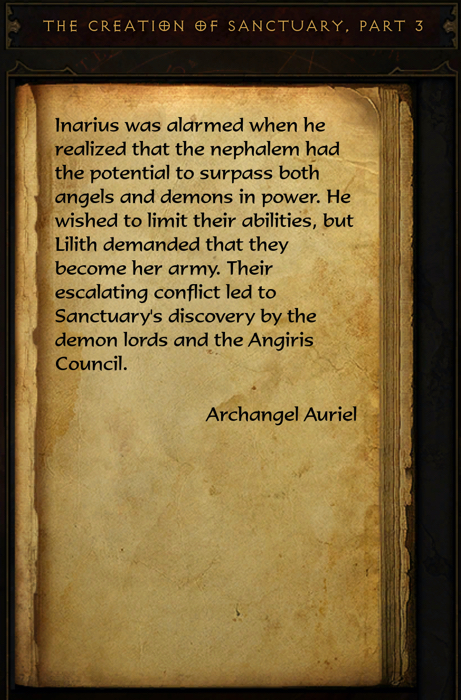
Archangel Auriel: Inarius was alarmed when he realized that the nephalem had the potential to surpass both angels and demons in power. He wished to limit their abilities, but Lilith demanded that they become her army. Their escalating conflict led to Sanctuary’s discovery by the demon lords and the Angiris Council.
How would Auriel know that Lilith wanted the Nephalem to become her army? It is possible that Inarius mentioned this some time after the battle ended, and before Mephisto hauled him off to the Burning Hells.
The Creation of Sanctuary, Part 4 says:
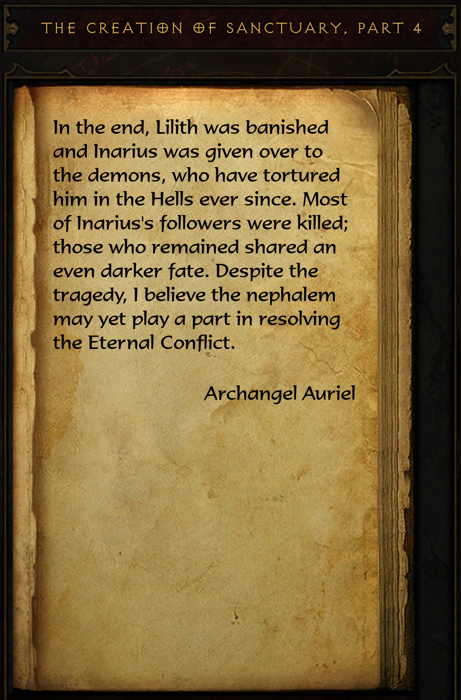
Archangel Auriel: In the end, Lilith was banished and Inarius was given over to the demons, who have tortured him in the Hells ever since. Most of Inarius’s followers were killed; those who remained shared an even darker fate. Despite the tragedy, I believe the nephalem may yet play a part in resolving the Eternal Conflict.
Itherael, Archangel of Fate, also voted to allow the humans to live. Players can find some of his journals in-game. These journals provide some insight into how the Archangel of Fate perceives the universe (for lack of a better word).
The Destiny of the Nephalem, Part 1 says:
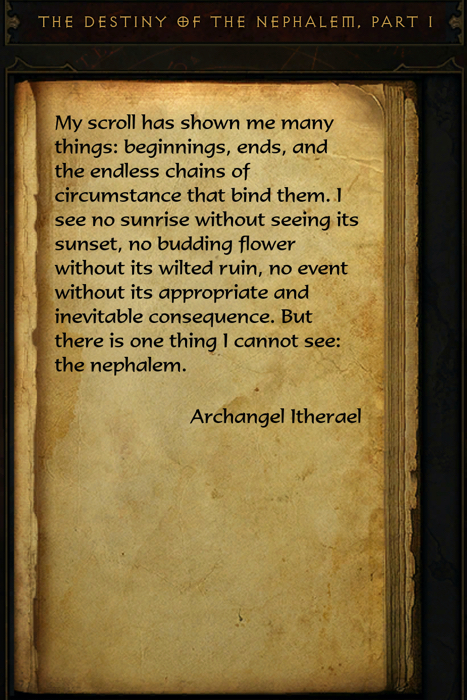
Archangel Itherael: My scroll has shown me many things: beginnings, ends, and the endless chain of circumstances that bind them. I see no sunrise without seeing its sunset, no budding flower without its wilted ruin, no event without its appropriate and inevitable consequence. But there is one thing I cannot see: the nephalem.
The Destiny of the Nephalem, Part 2 says:

Archangel Itherael: Angels and demons are bound to their natures. Demons are given to chaos and deceit; angels to truth and order. That much is known. Some angels, like Inarius and Izual, have fallen, but the seed of goodness remains within them like a fading star in the lonely night. The nephalem alone have choice.
The Destiny of the Nephalem, Part 3 says:
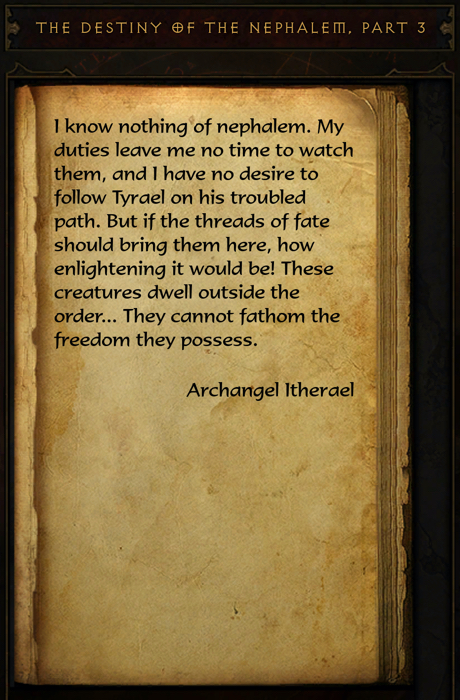
Archangel Itherael: I know nothing of the nephalem. My duties leave me no time to watch them, and I have no desire to follow Tyrael on his troubled path. But if the threads of fate should bring them here, how enlightening it would be! These creatures dwell outside the order… They cannot fathom the freedom they possess.
Archangel Auriel’s journals evoke a feeling of sadness, as if she mourned for the loss of her friend Inarius. But, she feels hopeful about the nephalem.
Archangel Itherael, on the other hand, isn’t thinking about Inarius at all. Instead, he’s very excited by the possibility for the nephalem to, one day, visit the High Heavens. It doesn’t sound like he wants to make friends with them, though. He wants to be enlightened by these beings that he cannot see within the scrolls of fate.
Tyrael, Archangel of Justice, after considering the potential of the humans, voted to allow them to live. According to the Book of Cain, Tyrael had become fascinated with the humans. In them, he saw both the possibility for complete destruction to happen and the potential for hope.
Malthael, Archangel of Wisdom, abstained from voting. The result was a three to one vote to let the humans live.
Before the Angiris Council left Sanctuary, they removed all memories of The Sin War, and the events leading up to it, from the minds of the humans. They were left to develop into whatever they would become.
That was the agreement. Of course, the demons returned to Sanctuary from time to time, and some of the Angiris Council also made appearances.
What Happened in Sanctuary… is a post written by Jen Thorpe on Book of Jen and is not allowed to be copied to other sites.
If you enjoyed this blog post please consider supporting me on Ko-fi. Thank you!

2 comments